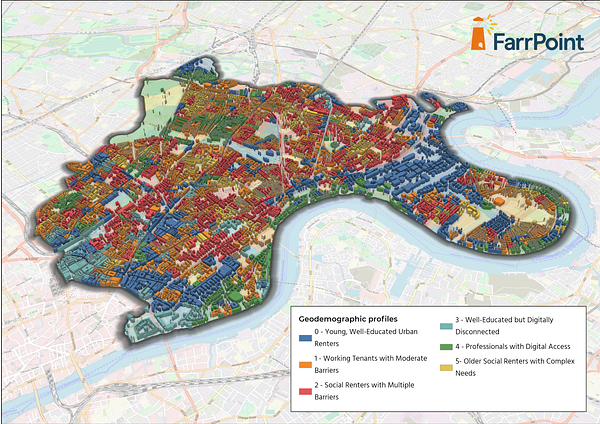
Anna Stewart sat down with FarrPoint’s Digital Inclusion Lead, (this will open in a new window)Dr Joe Chambers, for the latest feature of 'Consultants in Conversations', discussing how communities can make the most of digital technology and why it's important.

Digital inclusion is about ensuring everyone, regardless of background, income, or location, can access and benefit from digital technologies. It’s not just about having internet access; it’s about the skills, confidence, and motivation to use it effectively. As services like banking, healthcare, and utilities move online, digital exclusion can deepen existing inequalities, and so is something we urgently need to address.
People without digital skills or access to digital tools are often unable to apply for jobs, access public services, or take advantage of cost savings from online deals. In the UK, studies show that those who are digitally excluded can pay an average of £348 more per year on their energy bills because they cannot switch to better tariffs or use smart meters effectively.
Ignoring digital inclusion risks creating a society where opportunities, services, and even basic rights are increasingly available only to those who can confidently use digital tools. It could deepen existing inequalities, leaving already disadvantaged groups further behind in education, employment, and access to essential services. Digital exclusion isn’t just a technology issue; it’s a social justice issue.
Technology has enormous potential to bridge divides, but it’s not a magic solution. AI, smart devices, and online services can improve accessibility, streamline learning, and connect communities, but only if people have the skills, confidence, and infrastructure to use them. Without intentional inclusion efforts, these innovations could actually widen the gap, creating a world where only some people benefit from technological progress.
The impact of digital exclusion can be even more pronounced in developing countries, where it can further compound already existing and severe inequalities. Infrastructure often remains the biggest challenge in rural areas in the global south, which lack even basic internet access. There’s also the issue of affordability; many people can’t afford smartphones or data plans. Even when connectivity exists, a lack of digital literacy can prevent people from making full use of online resources. Addressing these challenges requires coordinated efforts between governments, NGOs, and the private sector.
Tackling digital exclusion requires a coordinated approach across infrastructure, education, and policy. Governments can provide subsidies for devices and broadband access, while organisations can work with community groups to offer digital skills training. Regulation should ensure that digital services are accessible to people of all skill levels.
A key challenge is understanding the true scale and nature of digital exclusion. Many governments and organisations recognise it as an issue, but lack clarity on where to start. Mapping the profiles of digitally excluded groups within communities, assessing existing support, and gathering insights from stakeholders can help design evidence-based interventions. By evaluating the impact of these interventions, governments and organisations can identify gaps and develop targeted strategies to ensure everyone benefits from digital services.
At FarrPoint, we have worked with local authorities, such as North Ayrshire, Tees Valley and Tower Hamlets, to better understand digital exclusion in their regions and support the design of interventions and policies to address it effectively.
It is also great to see central and devolved governments launch funding programmes to bridge digital gaps in the UK. DSIT recently announced their (this will open in a new window)Digital Inclusion Innovation Fund, and the Scottish Government has launched the (this will open in a new window)Connecting Scotland Digital Inclusion Fund. We've helped a few councils submit bids for such funding so if you'd like to know more, get in touch.
Our work with Tower Hamlets demonstrates how targeted, evidence-led approaches can drive real impact. FarrPoint supported the Borough by conducting an independent review of their digital inclusion strategy, combining socio-demographic analysis, policy evaluation, and stakeholder engagement. The review revealed where digital exclusion is concentrated, which groups are most affected, and how policies could be better tailored to meet community needs. The insights directly informed the Borough’s 2025–2028 Digital Inclusion Action Plan, ensuring support is targeted and practical, helping residents who are motivated to get online access to the right resources.

The future will depend on how well governments and businesses prioritise inclusion as technology advances. AI, automation, and IoT will continue shaping our world, but without proactive measures, these innovations may only serve to widen digital divides. The key is ensuring that everyone, not just the digitally savvy, can benefit from these advancements. That means investing in infrastructure, education, and policies that put people first.
At FarrPoint, we work with organisations to better understand the realities of digital exclusion, to design and evaluate digital inclusion interventions and develop policy and actions that can address these. Whether you’re a local authority, a charity, or an ISP, we can help you ensure that your digital services are accessible to everyone. Get in touch or visit our service page to learn more.
Connectivity is important. It drives business and society, bringing communities and commerce together. That's why we use our insight and experience to connect people and business.